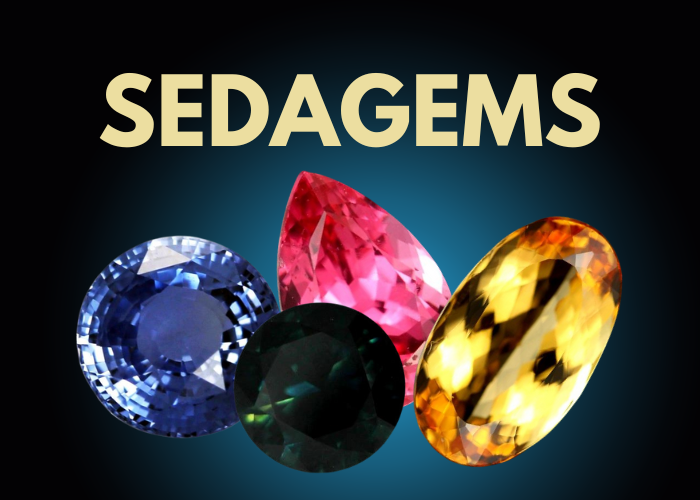12.45 CTS ALEXANDRITE - SPECIMEN FROM TANZANIA [S-SAFE249]
- SKU
- 寸法(mm)
- 10.000 x 7.000 x 6.000mm
- 重さ (CT)
- 12.450
- タイプ
- Specimen
- 色
-
ALEXANDRITE SPECIMEN
This is a natural untreated Alexandrite specimen from Tanzania which i bought from the miner on my last trip there. They are not suitable for faceting but can be cabbed or kept as a specimen.
The most sensational feature about this stone, however, is its surprising ability to change its colour. Green or bluish-green in daylight, alexandrite turns a soft shade of red, purplish-red or raspberry red in incandescent light. This unique optical characteristic makes it one of the most valuable gemstones of all, especially in fine qualities.
Alexandrite is very scarce: this is due to its chemical composition. It is basically a chrysoberyl, a mineral consisting of colourless or yellow transparent chrysoberyl, chrysoberyl cat’s eye and colour-changing alexandrite (also in cat’s eye varieties). It differs from other chrysoberyls in that it not only contains iron and titanium, but also chromium as a major impurity. And it is this very element which accounts for the spectacular colour change. Rarely, vanadium may also play a part. According to CIBJO nomenclature, only chrysoberyls displaying a distinct change of colour may be termed alexandrite.
Like many other gemstones, alexandrite emerged millions of years ago in a metamorphic environment. But unlike many others, its formation required specific geological conditions. The chemical elements beryllium (a major constituent in chrysoberyl) and chromium (the colouring agent in alexandrite) have contrasting chemical characteristics and do not as a rule occur together, usually being found in contrasting rock types. Not only has Nature brought these contrasting rock types into contact with each other, but a lack of the chemical element silica (the second most common element in the Earth’s crust) is also required to prevent the growth of emerald. This geological scenario has occurred only rarely in the Earth’s history and, as a result, alexandrite crystals are very scarce indeed.
- SKU
- 寸法(mm)
- 10.000 x 7.000 x 6.000 mm
- 重さ (CT)
- 12.450
- タイプ
- Specimen
- 色
-
ALEXANDRITE SPECIMEN
This is a natural untreated Alexandrite specimen from Tanzania which i bought from the miner on my last trip there. They are not suitable for faceting but can be cabbed or kept as a specimen.
The most sensational feature about this stone, however, is its surprising ability to change its colour. Green or bluish-green in daylight, alexandrite turns a soft shade of red, purplish-red or raspberry red in incandescent light. This unique optical characteristic makes it one of the most valuable gemstones of all, especially in fine qualities.
Alexandrite is very scarce: this is due to its chemical composition. It is basically a chrysoberyl, a mineral consisting of colourless or yellow transparent chrysoberyl, chrysoberyl cat’s eye and colour-changing alexandrite (also in cat’s eye varieties). It differs from other chrysoberyls in that it not only contains iron and titanium, but also chromium as a major impurity. And it is this very element which accounts for the spectacular colour change. Rarely, vanadium may also play a part. According to CIBJO nomenclature, only chrysoberyls displaying a distinct change of colour may be termed alexandrite.
Like many other gemstones, alexandrite emerged millions of years ago in a metamorphic environment. But unlike many others, its formation required specific geological conditions. The chemical elements beryllium (a major constituent in chrysoberyl) and chromium (the colouring agent in alexandrite) have contrasting chemical characteristics and do not as a rule occur together, usually being found in contrasting rock types. Not only has Nature brought these contrasting rock types into contact with each other, but a lack of the chemical element silica (the second most common element in the Earth’s crust) is also required to prevent the growth of emerald. This geological scenario has occurred only rarely in the Earth’s history and, as a result, alexandrite crystals are very scarce indeed.
| 配送業者 | 配送先Australia | その他の国への配送 |
|---|---|---|
| FedEx | $12.00 / 3 | $39.00 / 10 |
|
:国
FedEx 、 2以上のアイテムを含む注文で$12.00に割引されます
世界のその他の地域
FedEx 、 2以上のアイテムを含む注文で$39.00に割引されます
|
||
| Registered Shipping | $9.00 / 7 | $16.00 / 21 |
|
:国
Registered Shipping 、 2以上のアイテムを含む注文で$9.00に割引されます
世界のその他の地域
Registered Shipping 、 2以上のアイテムを含む注文で$16.00に割引されます
|
||

-
 ポジティブ
ポジティブI'm expecting an experience of good reasoning.
-
 ポジティブ
ポジティブThank you lovely specimen
-
 ポジティブ
ポジティブwonderful specimen
-
 ポジティブ
ポジティブwow -- amazing texture & translucence!
-
 ポジティブ
ポジティブReceived!!!! So awesome! Thank you so much! Will definitely be visiting your store again soon.




![3 CTS AUSTRALIAN PINK SAPPHIRE PARCEL [ST9105]](https://liveplatforms-production.b-cdn.net/tenants/gr/uploads/images/450000-454999/451760/542b8f8946946.JPG?width=480&aspect_ratio=1001%3A1000)
![78.90 CTS MALACITE CRYSTAL SPECIMENS -MOROCCO [MGW3808]](https://liveplatforms-production.b-cdn.net/tenants/gr/uploads/images/390000-394999/392954/529edd307ace0.JPG?width=480&aspect_ratio=1001%3A1000)





![16.00 CTS CHERRY BLOSSOM SILVER /GOLDEN PARCEL [STS1679]](https://liveplatforms-production.b-cdn.net/tenants/gr/uploads/images/1100000-1104999/1100803/5e1bb182052f4.jpg?width=480&aspect_ratio=1001%3A1000)


